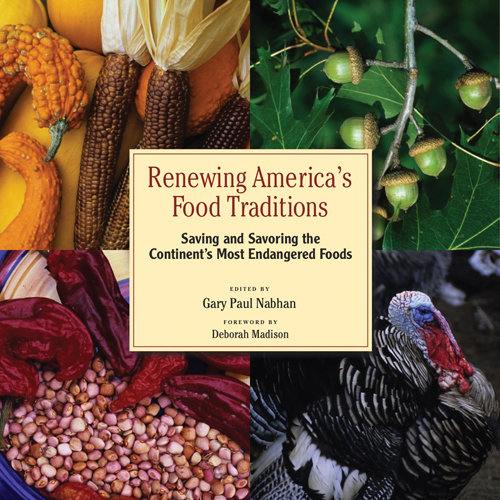Renewing America's Food Traditions

A casual look around our country’s food supply reveals little more than a mix of sprawling, commercialized monocultures. Plants are grown and animals are raised with an eye to efficiency and profit. The nation’s highways swarm with worker-ant trucks that shuttle our agricultural products 1400 miles, on average, between the farm and the plate.
But take a close look, and you’ll see something different on the edges: The last remnants of America’s native foodstuffs and our pre-factory-farm agriculture. These are foods with real flavor, not the stripped-down blandness of food raised more for shippability than taste. Heritage turkeys have enjoyed the spotlight of the food press, but these are only the beginning if you know where to look.
If you don't know where to look, however, Renewing America’s Food Traditions is a good place to start. The book divides the United States into “food nations” (a practice already in place at Renewing America’s Food Traditions (RAFT) the organization, which birthed the book). A large swatch of California, for instance, is Acorn Nation — a name that rings true to someone like me who learned about acorn grinding holes at summer camp in the Sierra Nevada foothills. Alaska, not surprisingly, is Salmon Nation. The southeastern coast is Crab Nation. And so on. The names evoke the food patterns of the cultures who lived off the native bounty long before semis and trains connected every point in the U.S. with every other point.
Each of the book’s small and well-written vignettes focuses on one particular “heritage” food from the food nation that defines each section, focusing on one or two people deeply involved in preserving that food. Some, such as Honey Drip Cane Sorghum, I had never heard of. Some, such as the Olympia Oyster, are treats that I already seek out. Lovely photos and simple recipes accompany each piece. And — you other research-happy food writers will appreciate this — each two-page essay gives a list of resources where you can learn more about the food.
But not where to buy it. This is my only complaint about this book, which could live on your reference shelf or your coffee table with equal ease. I can understand why there aren’t instructions for poaching leatherback sea turtles. But where do I buy a Silver Fox rabbit?
It could be that the authors don’t want to contribute to the shuttling of food around the country — the editor is locavore founding father Gary Paul Nabhan, after all — but it seems unfair to build up interest in these foods and then snatch away the chance to find them.
But this is a must-have book for any food lover who cares about the more interesting ingredients available throughout our country.
This book was sent to me for review.
Hey all, there’s still room in my upcoming UCB Extension wine class. Sign up soon!
- Go To Jojo
Over the years, I have urged my Bay Area readers to go to Jojo in Oakland. Sometimes I’ve done so overtly, but I have always kept a link to it on the right side of this blog. Melissa and I have many happy memories tied to the restaurant and its...
- Sf Chronicle: Vineyard Nurseries
If you’ve already seen the lead story in the Chronicle’s Wine section, I know what you must be thinking: “Geez, Derrick, how cliched can you get? A story about vineyard nurseries?” No, wait. I’m thinking of a different topic....
- Wine Gadgets The World Needs
Lore Sjöberg, who often writes humorous pieces for Wired, has put his satirical pen to paper and pondered the wine gadgets missing from the world. An automatic wine twirler? A tooth-mounted flavor sensor? A temporal acceleration device to age your...
- Mr. Manners On Dinner Parties
Many of you know that I’m a devoted listener of the Grammar Girl podcast. In today’s episode, she mentioned that Mr. Manners, one of the other podcasts in the same network, recently talked about dinner parties. There are transcripts for part...
- Mark Morford On The Baconator Ads
In Mark Morford’s latest opinion column for the San Francisco Chronicle, he rants about the new Wendy’s ads — and our culture of gluttony — in his typical stream-of-consciousness style. I guess everyone’s writing about food...
